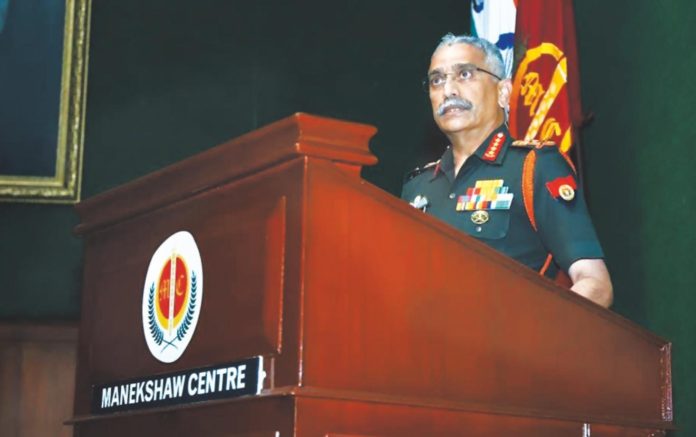
Speaking at an international seminar on “Changing Characteristics of Land Warfare and its Impact on the Military” organised by Centre for Land Warfare Studies (CLAWS), on 4 March, Gen MM Naravane, chief of the army staff (COAS) said, that the Army was embracing technologies and inducting them with speed into units. “The leveraging of emerging, disruptive domains is also receiving our concerted attention. Capacities in space, cyber and electronic warfare, similarly, are being given a boost,” he said.
Apart from strengthening conventional prowess, the Army was focusing on dynamic response – that would mean actions below the threshold of an all-out war, as shown during the Balakot air strikes in February 2019 – and plans and capacities were being refined along the Line of Control (LoC) with Pakistan and Line of Actual Control (LAC) with China.
“For years we were told that if air power is used across the international border, it would escalate to a full-fledged war. Balakot demonstrated if you play the escalatory game with skill, military ascendancy can be established in short cycles of conflict that do not necessarily lead to war,” Naravane said.
“If the target country does too little, it faces the prospect of a series of small but cumulatively significant defeats. If it does too much, it risks being held responsible for reckless escalation,” Naravane said.
A few days earlier the Indian Air Force (IAF) chief, Air Chief Marshal RKS Bhadauria, had asserted that the Balakot air strikes showed there was scope for taking out targets in Pakistan below the threshold of conventional war.
Information Warfare
“The Houthi rebels’ attack on Riyadh airport and oil facilities in Saudi Arabia and closer home, the Balakot air strike, saw these short, intense, escalatory cycles of military activity, in full media glare, where sophisticated information narratives played an equally important role,” said Gen Naravane.
Terming it a “technological irony”, he said the so-called Islamic State had shown it was far more adept in leveraging social media and digital technologies than the 21st-century militaries of the US and the UK.
“The rise of non-state actors, such as insurgents, terrorists, transnational criminal networks combined with greater focus on an individual’s status consequently demands that victory needs to be formulated and achieved in a more nuanced way. Victory no longer rests on the ability to inflict massive destruction but on the ability to wrestle popular support from one’s opponent,” he said.
China’s Created An Aura of Might
Militaries “play to the edge” in the “grey zone” now. China through its incremental moves in the contentious South China Sea, for instance, is altering geo-strategic realities in the region without firing a single shot or inviting any retaliatory action.
“China has not been involved in real, hardcore combat for a few decades now; yet the regular showcasing of its military might have created this aura of China being the undisputed military leader in key technological domains – with deterrence logic of its own,” Naravane said.
“Technological leadership need not always be demonstrated through live conflict and war. China has not been involved in hardcore combat for a few decades now, yet the regular showcasing of military might have created this aura of Beijing being the undisputed military leader in key technological domains,” he added.
Lasers and DEWs
Gen Naravane said the Army was looking at lasers and directed energy weapons for possible military use. With the 20th-century icons like the main battle tanks and the fighters gradually on their way out in the future wars, the Indian Army is looking at new technologies like laser and directed energy weapons.
Dwelling at length on the Chinese way of war epitomised by thinkers like Sun Tzu as well as the continuing relevance of Indian philosopher Chanakya’s famed treatise “Arthashastra”, he said the country was developing both “kinetic and non-kinetic responses” to address the threat of “non-contact or grey-zone warfare”, where ambiguity and careful risk escalation are key.
“We are developing kinetic and non-kinetic responses to address the threat. Technology is also tipping doctrinal cycles. Doctrines are now chasing technologies. We are also looking at tapping ‘block chain technologies’ (these allow digital information to be distributed, but not copied),” the Army Chief added.
Rapidly evolving, dual-use technologies present new opportunities and are changing the character of warfare. Armies, have to be extremely agile to the scale and pace of change.
Space, Cyber Warfare
India is strengthening its capabilities in space, cyber and electronic warfare, while also looking to tap blockchain technologies, lasers and directed energy weapons, he said. He said combat was no longer confined to the physical domain and strategic-military competition was playing out in the technological battle space like never before.
Non-contact Warfare
With the geo-strategic realities changing without a single shot being fire is indicative of the changing nature of warfare. However, it is not possible to wish away Main Battle Tanks and fighter aircraft cannot be ruled out totally, says an expert.
He cited China’s example of how Beijing had altered geo-strategic realities and strengthened its position in the South China Sea “without a shot being fired”. Moves in the “grey zone” are ambiguous that leave target countries unsure as to how to respond, he said.
Naravane said “the grey zone and its varied nuances” in the Indian context had not skipped the army’s attention.


















[…] ALSO READ Future Military Technologies : Gen MM Naravane on Changing Characteristics of Warfare […]